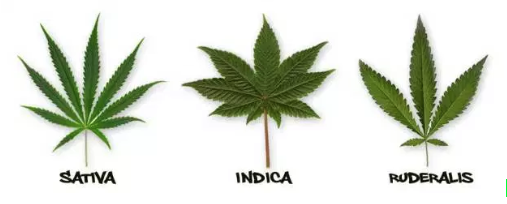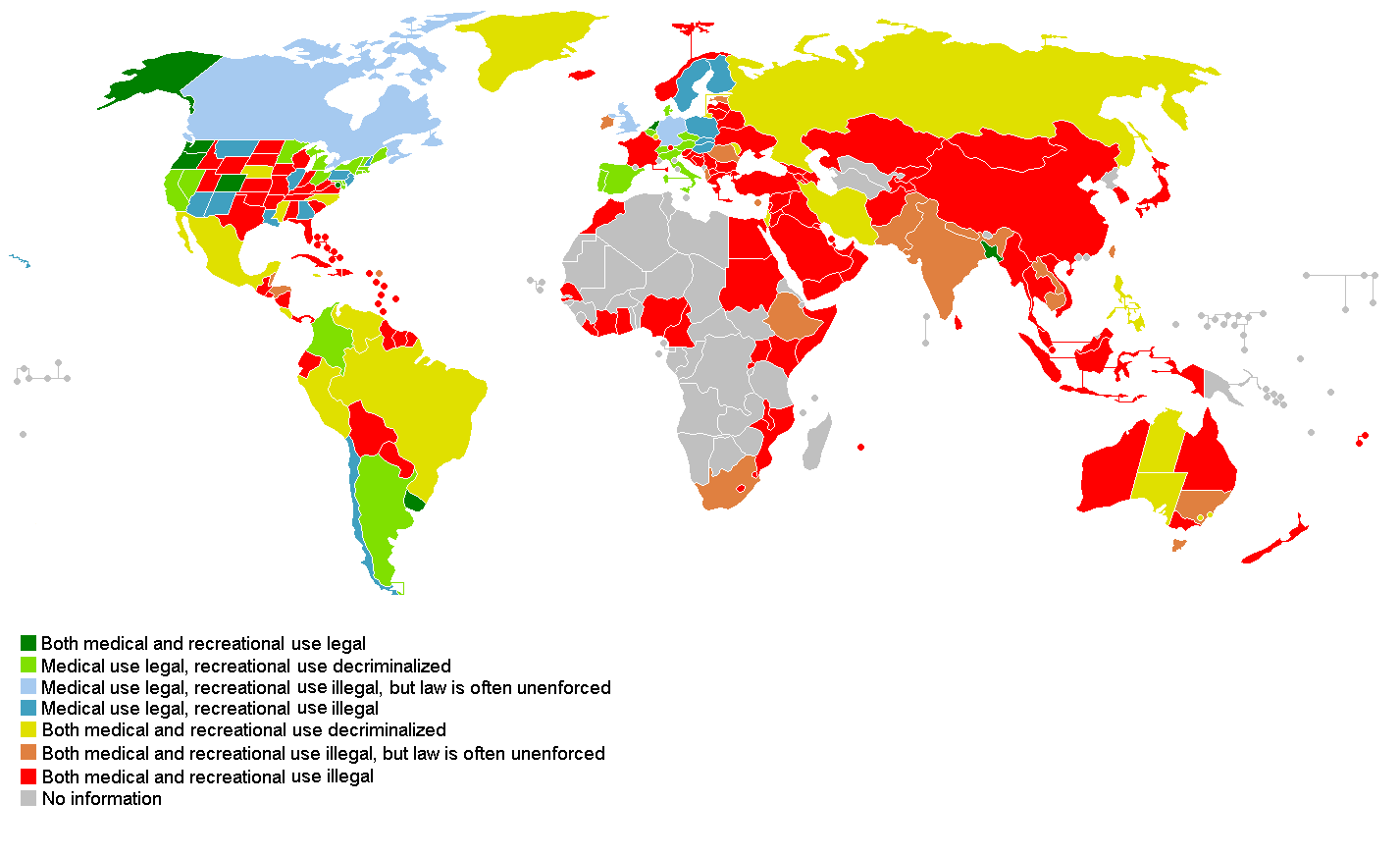Table of Contents
Cannabis
Origin and Evolution
Cannabis is a flowering plant in the family Cannabaceae. Cannabis use has been traced back to early as 4000 B.C. in china in the form of hemp (Touw, 1981). The use of cannabis is not new. People have grown and processed cannabis for many practical and medicinal purposes for thousands of years. Where the plant originated is not conclusive to an exact location, however it is thought to be first found in central asia (Touw, 1981). Over the many years that cannabis has existed it has evolved into different forms. Many people believe this split in species came about long before humans began to interact with the plant. Cannabis can now be broken down into three main species known as Sativa, Indica, and Ruderalis. Cannabis Sativa is a tall plant with narrow leaves, and can grow upto 10 feet tall. Additionally, this species may have psychoactive components, but if it does not, it is known as hemp. Indica is another form of the plant. It is characterized by short and bushy leaves along with a psychoactive properties. Lastly, Ruderalis is a form of cannabis that is short and unbranched and is relatively weak in its psychoactive properties compared to Indica (Sharp, 2018). The growth of cannabis requires various conditions and climates. Temperate and tropical regions is where the plant will thrive best, as the plant grows in warm temperatures with sunlight and moist soil (Sharp, 2018).
Uses
Cannabis use varies among individuals and is known to have a wide range of different uses. Primarily, cannabis is found to be used medicinally, recreationally, industrially, and religiously. Recreational cannabis use has increased over the last couple of decades and has spread globally (Touw, 1981). It has become the most illegally used drug in the world and its effects are known to be triphasic. There are primary, secondary, and tertiary effects of cannabis and they range from feelings of relaxation, euphoria, philosophical thinking, and even increases in hunger and heart rate (ADF, n.d). Another major use of cannabis is medicinally. The medical use of cannabis refers to the use of its components such as cannabinoids in order to treat various symptoms or various diseases. Industrially , cannabis has been used since 12000 B.C. as hemp. Hemp is the term used to describe the soft fiber obtained from the cannabis stem. It is used in variety of products ranging from paper, to construction material, to clothing. Lastly, cannabis has been used religiously for many years. It’s religious uses vary from religion to religion. In general it is used to create an entheogenic experience (ADF, n.d). Cannabis can be consumed in various forms for those recreational, medicinal, and religious uses. The drug can be smoked or eaten, and comes in different forms to do so. One form is marijuana. This is the most common form, and is dried leaves of the cannabis plant that can be smoked in a bong or in a joint (Department of Health & Human Services, 2013). Another form known as hashish is dried plant resin with a higher concentration of THC than marijuana. This form of the cannabis is typically smoked, or baked into food items known as edibles. Lastly, concentrates which are extracts that commonly use hash oil as a solvent, may be smoked or vaporized. This form is usually used in small quantities due to its high potent THC content (Department of Health & Human Services, 2013).
Demographics and Prevalence of Cannabis Use
The United Nations Office on Drugs and Crime (UNDOC) has reported that in 2015, the highest prevalence of cannabis use was in North America, Western Central Africa, as well as Oceania (WHO, 2018). Specifically, from the years of late 1960s to 2015, there is seen to be periods of an increase in the use of cannabis and a decrease in Canada (Statistics Canada, 2017). For example, during the time of 1960s and early 1970s, an increase of consumption was seen in the ages of 15-24. However, this then started to decline in the 1990s, but gradually increased within the 2000s (Statistics Canada, 2017). Overall, there has been a general increase in the usage for the entire age population. Furthermore, a recent report has shown that high school students in Ontario use cannabis as the most used illicit drug (Statistics Canada, 2017). It is seen that in a sample of individuals of aged 15 and over, around 45% of them said that they had tried to use cannabis at least once in their lifetime. From the Canadian Alcohol and Drug Use Monitoring Survey (CADUMS) conducted by Health Canada, a survey was conducted from individual’s ages over 15 within 10 provinces and was conducted over the year of 2015 from volunteers (Statistics Canada, 2017).
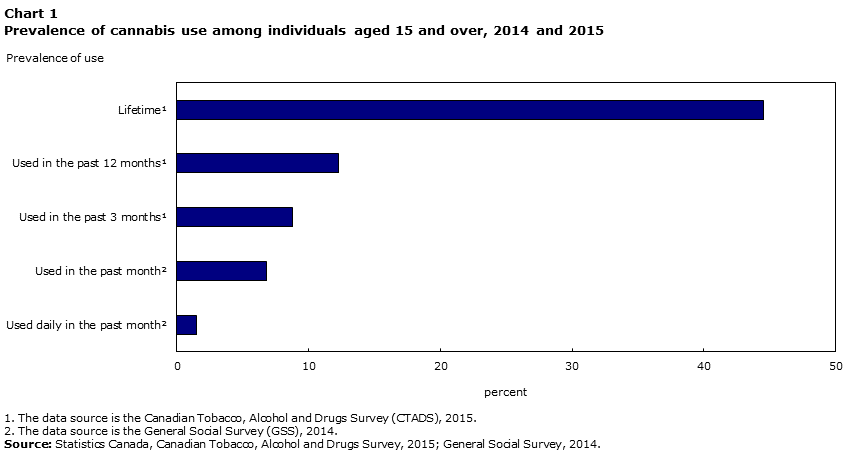 Figure 2. Prevalence of cannabis use in individuals ages 15 and over distributed by frequency in use
Figure 2. Prevalence of cannabis use in individuals ages 15 and over distributed by frequency in use
From these individuals who have used cannabis, it is seen that the use is not equally distributed as those who have used cannabis within the year of 2015 were in their 20s and then decreases steadily as the age increases. In those who are over the age of 55, majority have not used cannabis within the past year. Furthermore, it has been reported that 48% of men has used cannabis at least once in their life and 32% of women has used it once (Statistics Canada, 2017).
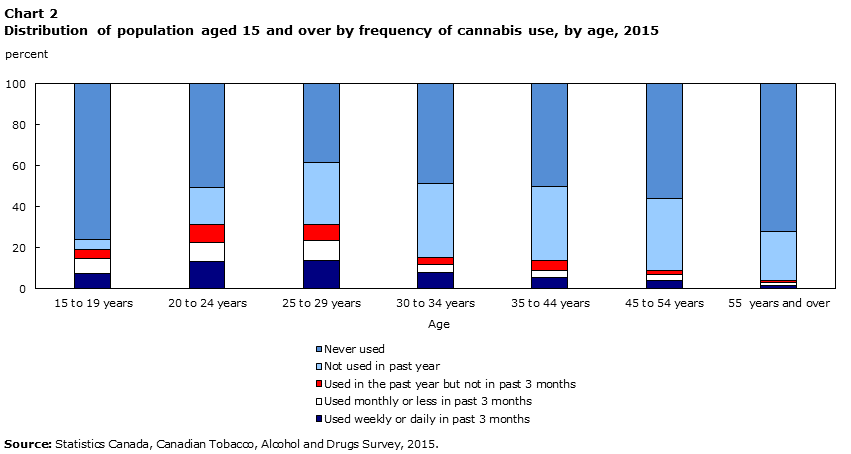 Figure 3. Frequency of cannabis use in individuals ages 15 and over in 2015 distributed by age
Figure 3. Frequency of cannabis use in individuals ages 15 and over in 2015 distributed by age
Short-term Effects of Cannabis
The short-term health effects from Cannabis can include positive and negative effects. The positive effects include ones such as:
- Relaxation
- A feeling of euphoria
- Sensory experiences such as a greater sense of sight, taste, smell, and sound (Government of Canada, 2018)
However, negative short-term effects can include:
- A feeling of fear or anxiety
- Inability to concentrate, remember certain tasks, or pay attention
- State of confusion (Government of Canada, 2018)
The smoke from cannabis can also cause a decrease in blood pressure and can damage blood vessels from the inhalation of smoke. Furthermore, those who use cannabis can have delusions or hallucinations so it is advised to be aware of any of these effects on the body (Government of Canada, 2018). It is not possible to overdose from marijuana, however, they may experience panic attacks as well as become paranoid which can lead to injury (NIDA, 2018).
Pathophysiology
Cannabis is generally divided in to two major types, one from dried leaves also known as marijuana and the other from fresh leaves also known as Hashish (Sharma et al., 2012). These leaves are then extracted, isolated and purified to be used or consumed. Within all the compounds in cannabis ere are two specific compounds that leads to the physiological effects of cannabis, the Delta 9-tetrahydrocannabinol (THC) and Cannabidiol (CBD).
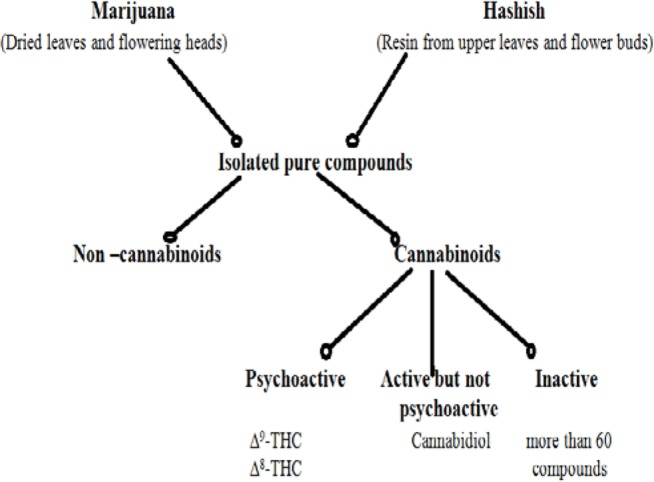 Figure 4. Types of cannabis with active ingredients.
Figure 4. Types of cannabis with active ingredients.
THC is known to have the major effect on the brain as its structure is very similar to the neurotransmitter Anandamide and will bind to the Cannabinoid receptors (CB1 and CB2) and disturb the chemical neurotransmission (Figure 2). However, THC does not directly cause the “high” experience in an individual (Pertwee, 2008). When the THC enters the body, the CB1 and CB2 receptors are stimulated to inhibit the Gamma-Aminobutyric Acid (GABA) and glutamate pathways (Perlman, 2018). These two pathways are responsible of the inhibition and regulation of dopamine. Thus the increase in dopamine level cause one to feel “rewarded” giving them the “high” experience. While Cannabidiol on the other hand is thought to be responsible for the experiences of paranoia and anxiety; however the specific mechanism of this is still unknown.
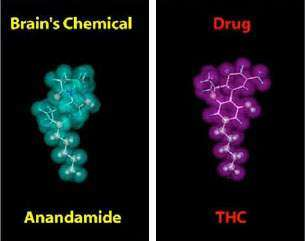 Figure 5. Molecular similarity between Anadamide to THC.
Figure 5. Molecular similarity between Anadamide to THC.
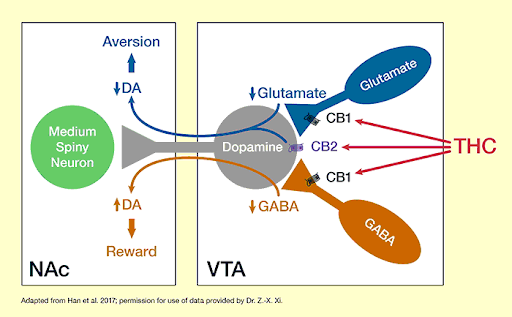 Figure 6. THC pathway to effect dopamine production.
Figure 6. THC pathway to effect dopamine production.
Cannabis primarily effects the hippocampus and the prefrontal cortex of the brain. Hippocampus is responsible for regulating emotions and forming memories and the prefrontal cortex is responsible for controlling the reward pathways. This is why we see that individuals who smoke cannabis will experience amnesia and the feeling of rewarded.
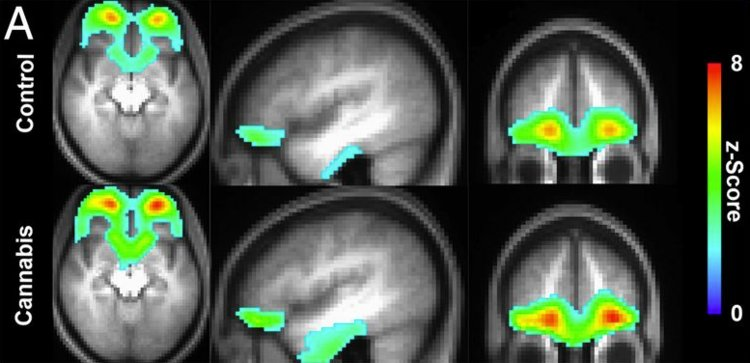 Figure 7. A PET scan comparing brain activity of a normal individual versus one who have just smoked cannabis.
Figure 7. A PET scan comparing brain activity of a normal individual versus one who have just smoked cannabis.
Medicinal Uses
Many controlled and uncontrolled studies have been done in order to measure the therapeutic potential of THC on various medical conditions. An example of an uncontrolled study was looking at the effect of THC on individuals diagnosed with trichotillomania (Grotenhermen and Müller-Vahl, 2016). Methods: Fourteen females, mean age of thirty three, diagnosed with the disorder were administered anywhere between 2.5-15 mg of THC over a 12-week span (Grotenhermen and Müller-Vahl, 2016). Results: This resulted in a significant reduction of hair pulling amongst all females in the study. In fact 9 of the women displayed a 35% reduction in symptoms following treatment (Grotenhermen and Müller-Vahl, 2016). Due to the fact that is was uncontrolled, it means other factors such as epigenetics and internal body chemistry could have played a role in the reduction of this. Scientists also conducted several controlled studies to measure the direct relationship between cannabis and other medical implications such as tourettes, spinal cord injury, Crohn’s Disease, and irritable bowel syndrome (Grotenhermen and Müller-Vahl, 2016). This was a case study regarding individuals diagnosed with Crohn’s Disease (Grotenhermen and Müller-Vahl, 2016). Participants in this study are patients who previously did not respond well to other well accepted therapy strategies (steroids, immunomodulators, etc.). One group was given cannabis cigarettes and other group was given placebo cigarettes for 8 weeks (Grotenhermen and Müller-Vahl, 2016). Complete remission in 5 of 11 subjects in cannabis group and 1 of 10 in placebo group. THC-rich cannabis produced significant effects without side effects (Grotenhermen and Müller-Vahl, 2016).
Spiritual Uses
Chinese Taoism
Emperor Shen Nung was the father of chinese medicine and was well aware of the psychoactive properties of cannabis. His texts explained that when smoking weed for a long period of time it bettered communication skills with the spirits (Keehn, 2015).
Indian Hinduism
In sacred hindu texts, it is believed that cannabis is one of the 5 sacred plants. They believed marijuana was a gift from the gods, offering happiness and would help people gain liberation (Keehn, 2015).
The Old Testament
In this text there was a moment where there was a burning bush in which Moses heard the voice of God. Many believe that this was a burning cannabis plant which was inspired to make anointing oil. This anointing oil was used for Jewish kings during crowning ceremonies (Keehn, 2015).
Rastafari
Many believe that the Tree of life mentioned in the bible is the marijuana plant and that several passages promote its use such as “thou shalt eat the herb of the field”. Rastas actually condemn the use of this substance for the sole purpose of getting high. Instead they believe it to be only used in religious ceremonies in order to enhance feelings of unity. A short prayer is often recited before the use of it (Dufton, 2015).
Recreational Use
Recreational use is defined as the act of intentionally altering one conscious state of mind to feel happy or exhilarated. This was just recently implemented in Canada under Justin Trudeau. Now, individuals of legal age, 18 or 19 years of age dependant on which province you reside in, can purchase marijuana controlled dispensary. Some Key Things to Note: You can grow up to a maximum of 4 marijuana plants in your household (Butler, 2018). Prices will range anywhere from 10 to 12 dollars a gram in Ontario, this price is provincial specific. You can fly with up to 30 grams of weed within the country but not on international flights (Butler, 2018). In terms of work, this is regulated provincially (i.e in Calgary, officers are forbidden the right to use marijuana recreationally before they start working while in vancouver it is the discretion of the officers to self-evaluate whether or not they are sober enough for duty (Butler, 2018). In terms of driving, if 2-5 nanograms of thc is found in the blood you can face a fine of 1000$, if more than 5 nanograms are found or the use of marijuana mixed with the use of alcohol, there are larger consequences. People may be faced with up to 10 years in prison (Butler, 2018)!
Long-term effects & benefits
Positive Effects
Research shows that the chemical compounds from Cannabis contain numerous pharmacological activities including antimicrobial, anticonvulsant, and anti-inflammatory effects, among other possible benefits (Ramirez, 2016). The endocannabinoid system involves the receptors, CB1 and CB2 which can be found in various organs throughout the body (Smith & Wagner, 2014). CB1 receptors are primarily located in the brain while CB2 receptors, which are involved in the immune system, can be found in the GI tract, liver spleen, and reproductive system (Smith & Wagner, 2014).
In terms of medicinal uses and pain management, various studies have identified that the endocannabinoid system plays a key role in psychiatric disorders such as anxiety, depression, bipolar disorder and schizophrenia as well as developmental disorders, including the autism spectrum disorder (Smith & Wagner, 2014). The literature also identifies clinical endocannabinoid deficiency as a root cause of the pathophysiology of migraines, fibromyalgia, and irritable bowel syndrome. Furthermore, cannabis consumption can alleviate nausea in chemotherapy patients, chronic pain symptoms as well as tics and muscle spasms in patients with Multiple Sclerosis and Tourette syndrome (Webb & Webb, 2014).
Between 2010 and 2011, Webb & Webb (2014) conducted a questionnaire to determine the efficacy of medicinal cannabis use for chronic pain in 100 patients. The response rate for the survey was 94%, and the findings showed a 64% relative decrease in average pain according to a 0-10 pain ranking scale. Additionally, 50% of patients reported a decrease in stress and anxiety and 45% said they no longer had trouble sleeping.
While the connection between cannabinoid receptors and these conditions has been well-established, the therapeutic benefits of cannabis use have not been tested as extensively due to governmental regulations and production restrictions in numerous countries (Smith & Wagner, 2014).
Negative Effects
The long-term effects of cannabis have not been studied extensively due to the substance being illegal in most countries. The potential negative long-term effects that have been identified in in the literature are primarily associated with early and regular consumption of cannabis in adolescents (Gruber et al., 2003).
A meta-analysis of over 6000 participants determined a correlation between early non-medicinal cannabis use in individuals under the age of 15 and an increased risk of dropping out of school and/or attaining a lower level of education (Hoch et al., 2015). Furthermore, early heavy consumption of cannabis, in combination with other potential environmental and genetic stressors such as trauma and abuse in childhood or a predisposition to psychosis, has been associated with an increased risk of psychotic disorders such as schizophrenia (Hoch et al., 2015).
Conclusion: Future of Cannabis
Legal Status
Countries that have legalized the medical use of cannabis (prescribed by a physician) include: Australia, Canada, Chile, Colombia, Croatia, Cyprus, Czech Republic, Finland, Germany, Greece, Israel, Italy, Jamaica, Luxembourg, Macedonia, Malta, the Netherlands, Peru, Poland, Portugal, the United Kingdom, and Uruguay (Kalvapalle, 2017).
Countries such as Brazil and France, have more regulations recording cannabis consumption and only allow the use of specific cannabinoids, such as Sativex. In Canada, Uruguay, the Netherlands and Spain, cannabis can be obtained without a medical prescription, whereas in the United States the legal status of cannabis varies by state (Kalvapalle, 2017).
Cannabis Research
Texts from Ancient Egypt and China illustrate the use of the cannabis plant for numerous purposes including the use of hemp seeds as sustenance and medicinal practices. Ancient texts describe the use of medical cannabis for relieving pain from hemorrhoids as well as rheumatism, gout and constipation.
Despite the widespread documentation of the substance, controlled studies on cannabis use as medicine in a clinical setting is low in prevalence. With the legalization of cannabis in Canada, a G7 country, as of October 17 2018, advocates of the substance hope that government regulations worldwide still become less strict regarding cannabis production, distribution and consumption. As cannabis becomes more widely accepted for medical purposes, this can lead to increased opportunities for research funding, more controlled studies, the discovery of novel uses for medical cannabis, safer drugs on the market and a cultural shift in attitude towards the substance.
References
ADF - Drug Facts - Cannabis, Weed, Marijuana. (n.d.). Retrieved from https://adf.org.au/drug-facts/cannabis/
Brodwin, E. (2015, March 18). Here's how different drugs change your brain. Retrieved November 30, 2018, from http://uk.businessinsider.com/brain-on-drugs-scans-2015-2
Budhut. (2018). Crohn's Disease and Marijuana: Can Pot Heal Your Gut? Retrieved from https://www.budhut.net/crohns-disease-and-marijuana/
Butler, P. (2018, October 17). Legal pot is here: What you need to know | CBC News. Retrieved from https://www.cbc.ca/news/canada/marijuana-faq-legalization-need-to-know-1.4862207
Canada, H. (2018). Health effects of cannabis - Canada.ca. [online] Canada.ca. Available at: https://www.canada.ca/en/health-canada/services/drugs-medication/cannabis/health-effects/effects.html [Accessed 19 Nov. 2018].
Department of Health & Human Services. (2013, August 31). Cannabis (marijuana). Retrieved from https://www.betterhealth.vic.gov.au/health/healthyliving/cannabis-marijuana
Dufton, E. (2015). The Use of Marijuana in the Rastafari Religion. Retrieved from https://pointsadhsblog.wordpress.com/2015/06/11/the-use-of-marijuana-in-the-rastafari-religion/
Ghanaian Chicago Community. (2013, October 26). Health Topic of the Week: Drug Facts: Marijuana. Retrieved November 30, 2018, from http://sankofaonline.com/archives/11600
Grotenhermen, F., & Müller-Vahl, K. (2016). Medicinal uses of marijuana and cannabinoids. Critical reviews in plant sciences, 35(5-6), 378-405.
Gruber, A. J., Pope, H. G., Hudson, J. I., & Yurgelun-Todd, D. (2003). Attributes of long-term heavy cannabis users: a case–control study. Psychological Medicine, 33(8), 1415-1422.
Hoch, E., Bonnet, U., Thomasius, R., Ganzer, F., Havemann-Reinecke, U., & Preuss, U. W. (2015). Risks associated with the non-medicinal use of cannabis. Deutsches Ärzteblatt International, 112(16), 271.
Kalvapalle, R. (2017, May 6). Weed around the world: What legal marijuana looks like in other countries. Global News. Retrieved from https://globalnews.ca/news/3378603/marijuana-laws-around-the-world/
NIDA for Teens. (2018). Drug Facts Chat Day: Marijuana. [online] Available at: https://teens.drugabuse.gov/national-drug-alcohol-facts-week/chat-with-scientists/popular-questions/marijuana [Accessed 19 Nov. 2018].
Perlman, W. R. (2018, March 08). Why Marijuana Displeases. Retrieved November 30, 2018, from https://www.drugabuse.gov/news-events/nida-notes/2018/03/why-marijuana-displeases
Pertwee, R. G. (2008). Ligands that target cannabinoid receptors in the brain: from THC to anandamide and beyond. Addiction biology, 13(2), 147-159.
Ramirez, M. R. (2016). Potential Health Benefits of Cannabis Extracts: A Review. Journal of Chemical and Biomedical Science. Vol, 2(1), 1-8.
Sharma, P., Murthy, P., & Bharath, M. S. (2012). Chemistry, metabolism, and toxicology of cannabis: clinical implications. Iranian journal of psychiatry, 7(4), 149.
Sharp, A. (2018, January 16). Understanding Cannabis: Its Origin, Its Evolution, and Its Species. Retrieved from https://siranaturals.org/cannabis-origin-evolution/
Smith, S. C., & Wagner, M. S. (2014). Clinical endocannabinoid deficiency (CECD) revisited. Neuroendocrinology Letters, 35(3).
Statistics Canada. (2018). Experimental Estimates of Cannabis Consumption in Canada, 1960 to 2015. [online] Available at: https://www150.statcan.gc.ca/n1/pub/11-626-x/11-626-x2017077-eng.htm [Accessed 19 Nov. 2018].
Touw, M. (1981). The religious and medicinal uses of Cannabis in China, India and Tibet. Journal of psychoactive drugs, 13(1), 23-34.
Webb, C. W., & Webb, S. M. (2014). Therapeutic benefits of cannabis: a patient survey. Hawai'i Journal of Medicine & Public Health, 73(4), 109.
World Health Organization. (2018). The health and social effects of nonmedical cannabis use. [online] Available at: http://www.who.int/substance_abuse/publications/cannabis_report/en/index5.html [Accessed 19 Nov. 2018].
